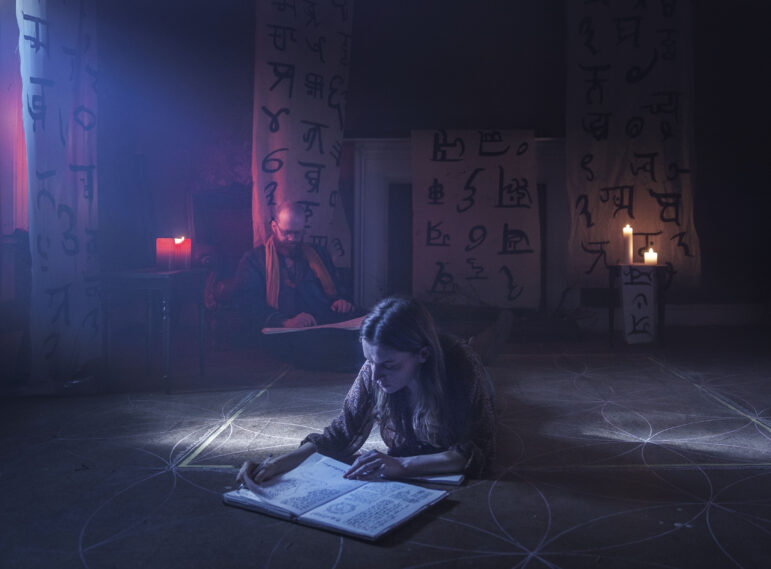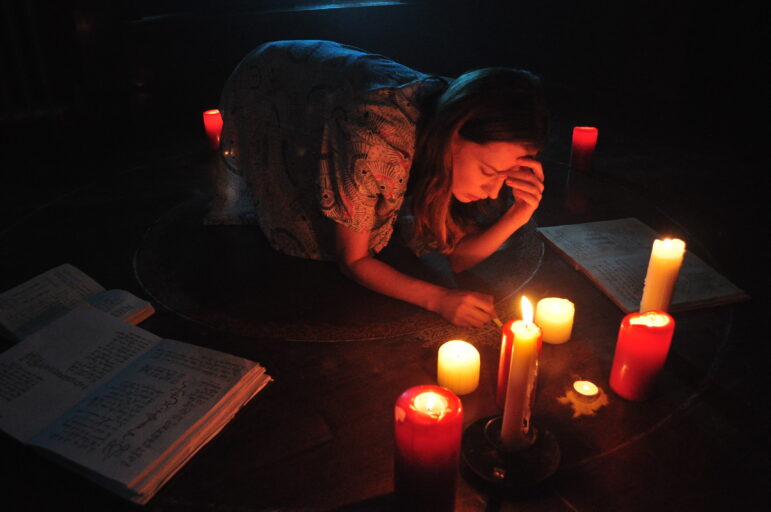
Classics of Pagan Cinema is a new occasional series in our Arts and Culture section where we explore the films that continue to resonate in the Pagan imagination year after year. Do you have a classic film with Pagan themes you would like to review for the series? Send a pitch to eric@wildhunt.org.
“Would you do black magic?”
“There’s no point in going to the fairgrounds if you’re not going to ride any of the rides.”
Liam Gavin’s A Dark Song is a 2016 Irish-British independent horror film about loss, vengeance, and ceremonial magic. It opens on a classic horror premise: a beautiful but troubled woman seeks the assistance of a substance-addicted and irascible occultist to undertake a secret ritual to obtain otherworldly powers.

Catherine Walker and Steve Oram in “A Dark Song” [Kaleidoscope Entertainment]
The song’s darkness is indistinct as we meet the players. Sophia Howard (Catherine Walker) tells her rental priest first that she seeks the love of someone who left her. When he’s reluctant to take that on, she admits she lost a child, and she says wants to hear her son’s voice again. This sounds closer to the truth, and Joseph Solomon (Steve Oram) believes her enough to take her money. Sophia has rented a palatial but empty house in Wales with rooms meeting ceremonial specifications: the right dimensions, windows facing east and west, and the like. Solomon joins her there and they prepare and provision themselves for a months-long sequestration, sealing the house in a circle of salt that cannot and must not be broken. Their endeavor is a ritual they call the Abramelin.
The Book of Abramelin is a 17th century German grimoire of unknown origin, appearing as 12 printed manuscripts in 1608. Multiple translations and versions exist, which is common of books of magic and occultism from the time. The book consists of four parts: an autobiography and travelogue of a man named Abraham of Worms on his way to Egypt; practical magical instructions arising from kabbalistic style methods; and two books of magical word squares, puzzles, and Hebrew talismans to obtain powers such as flying through the air, walking underwater, healing maladies, and even summoning armed guards or musicians and dancers.
The steps and elements Sophia and Solomon (two wise names, two unwise practitioners) perform will look familiar (if not precisely correct) to a ceremonial magician. They inscribe circles and triangles upon the floor, light candles and spill blood. They make magic word and number squares, inscribe prayers in Latin, German, Chinese, and Greek. Even a few glimpses of Enochian and Theban scripts appear. Sophia endures monastic purification, abstaining from meat, liquor, and sex. She fasts and presents herself to ordeals of freezing water, sleep deprivation, and days-long meditation in an unmoving seated position. Solomon robes himself for the work in the manner of a hermetic or O.T.O priest, and Sophia, true to the rules of both horror movies and most occult rituals, appears often vulnerably close to nude.
This is not, however, a film about sex magic. Though Solomon intimates early on that sex will be part of their invoking, it is not included in the Abramelin ritual, either in film or medieval text. Tensions between the two ebb and flow between violence and camaraderie, and Solomon deceives and cajoles Sophia into exposing herself to him while he masturbates, but this is not a part of the ritual. It’s just a common touchless assault. Though it’s a scene that may trigger some viewers, there is also immediate retribution for this violation.
Many of the themes in the film will be familiar to magical practitioners of all stripes. Sophia’s lies and Solomon’s intentions rise from the world of emanations, unspoken between them until it’s too late. Their crimes against one another are embodied in the world of formation, reminiscent of the experience of success in a working. The signs of success, of breaking through to another realm, take forms and shapes neither of the film’s magicians anticipate.
As these realms become less distinct from one another and the ritual starts to work, liminal space takes on a peculiar meaning. Aside from the construction of sigils for the ritual, which manifest spring petals in the winter and a shower of golden flakes raining from the ceiling, there are also frightening incidents bounded by the closing of doors, the refusal to make the way open for a spirit to pass, and a particularly strange scene when the last artifact of Sophia’s dead child — a little goblin figurine she carries with her through the house — slips into the space behind the electric dryer, irretrievable and gone.
So, too, will the signs of failure in a magical endeavor seem familiar to the longtime practitioner. After crossing esoteric and personal boundaries and making rash decisions, Sophia finds that all her carefully-written magical diaries have been blacked out while she slept. Other signs appear – a spectral dog, voices of the dead in the house, and wraithlike apparitions. But these are more metaphors, or more horror movie fodder, than the story of a risky and dangerous ritual. The film has precious few special effects, choosing practical scares in nearly every case and maintaining an eerie atmosphere without much CGI. This renders a delightful dark whimsy in the cinematography, and keeps the magic grounded in nature.
The circuitous pattern of seeking and desire, and how Sophia attains the ability to enact her true will, is resonant and moving. She finds that the ritual cannot be stopped or left behind, because she has become one with it. She discovers that what she thought she wanted will never be enough, and that the true path is always within. She learns the nature of sacrifice at the film’s genuinely terrifying climax. Unabashed collision with the divine, no matter how cavalierly we seek it, is not for the faint of heart.

Catherine Walker in “A Dark Song” (2016) [Kaleidoscope Entertainment]
Early in the film, Solomon tries to explain to Sophia why he got into this line of work to begin with. He tells her that the point of all this seeking, all this investigation, is to know. He wants to know that each of worlds beneath the world, the worlds inside the world, the other world, the world he has touched and can’t really name, is real. He’s had it proven to him – he’s seen it, and he cannot stop peeping. It is somewhat ironic then, that when asked what favor he will request from their costly and terrible working, he tells her he would like to be invisible. “It’s not what you think,” he tells Sophia. “I just want some quiet before the hell.”
In Solomon’s utterances, the viewer can find almost anything: fear of damnation, exhilaration in the working of a spell, misogyny, tenderness, and the truth inside the lie that only fiction can tell. This film does not instruct anyone in how to do a ritual, how to seek vengeance, or how to turn invisible. It doesn’t try to explain how a parent might get over the death of a child, or whether two people can share something as intimate as prolonged magical work and still remain essentially strangers to one another. It is nevertheless very good at depicting the wonders and terrors of magic that cannot be told.
A Dark Song was written and directed by first-time filmmaker Liam Gavin. It is available for streaming on Tubi, AMC, and Apple TV.
The Wild Hunt is not responsible for links to external content.
To join a conversation on this post:
Visit our The Wild Hunt subreddit! Point your favorite browser to https://www.reddit.com/r/The_Wild_Hunt_News/, then click “JOIN”. Make sure to click the bell, too, to be notified of new articles posted to our subreddit.
